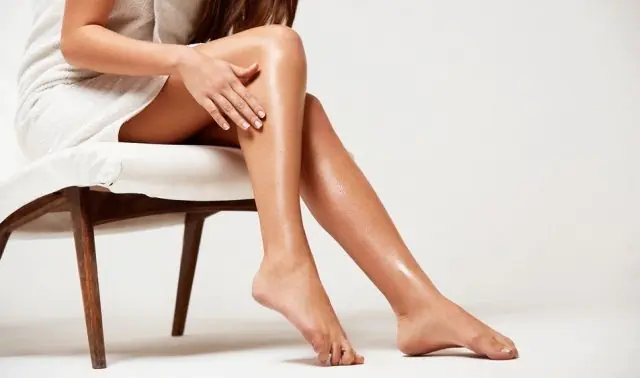
- Essence and types
- Causes
- Symptoms of the disease
- Complications - ingrown hairs
- Treatment: drug therapy
- Treatment: traditional methods
- How to reduce irritation
- Complications of folliculitis
Removing unwanted body hair is a popular cosmetic procedure for many people. Modern cosmetology offers many hair removal methods that effectively remove body hair. However, no matter how perfect the hair removal procedure is, no one is immune from unwanted consequences. Often after hair removal, irritation, redness, swelling or inflammation of the skin occurs. Moreover, this happens regardless of the chosen tool (tweezers, razor, hot wax, electric epilator, laser hair removal, etc.). Let's find out why this happens and how to get rid of unwanted skin irritation.
The essence and types of hair removal
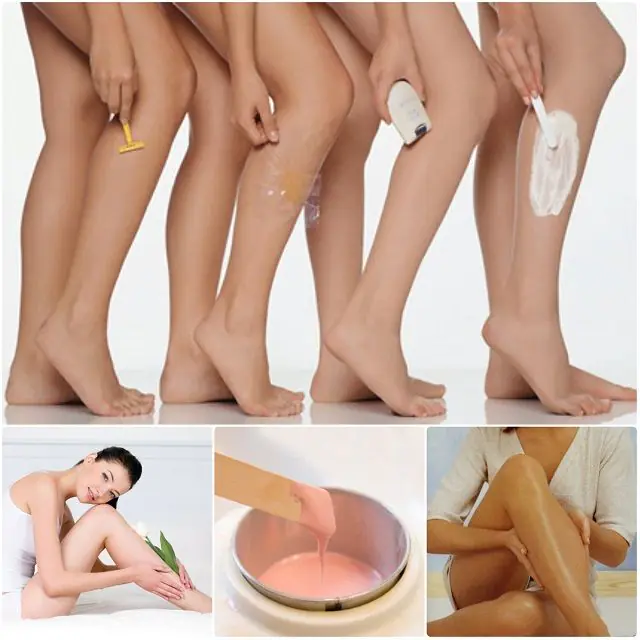
After hair removal, skin irritation is a normal reaction, since the procedure injures the skin and hair follicles. Hair removal can be done using hair removal and depilation, which have their own differences:
- Depilation - a procedure for artificially removing the visible part of hair without affecting the hair follicle. Depilation includes: shaving, chemical depilation, electric depilatory, hair removal with tweezers, waxing.
- Epilation - hair removal from the bulb (root). Subsequently, the hair that appears in this place becomes thinner and grows more slowly. The procedure affects the hair follicle and injures the skin.
In modern cosmetology, there are several types of hair removal:
- Laser hair removal is one of the most common painless hair removal procedures used by many women and men. The laser affects the melanin pigment in the hair, causing it to heat up and die. In one flash, the laser processes a large area, so the procedure takes place at high speed and takes little time. The disadvantage of laser hair removal is that if there is insufficient pigment (dark skin, light and gray hair), the laser beam is ineffective.
- Electrolysis - a current pulse is applied to the hair follicle with a special needle-electrode, which overheats it and the follicle dies. After this, the hair is removed with tweezers. This is the only procedure that is officially recognized as permanent hair removal, but not the first time. Since the effect takes place separately on each follicle, the session is long and several courses are required, because the “dormant” bulbs remain undamaged and begin to grow over time. The disadvantage of electrolysis is side effects: micro-abrasions, burns.
- Elos hair removal - a high-tech device that affects hair simultaneously with light pulses and electric current. The advantage of the procedure is hair removal regardless of color and fine fluff, which is difficult to get rid of with other types of hair removal.
- Photoepilation - exposure to light radiation on the melanin pigment in the hair root. High-pulse light acts very quickly, so the procedure does not take long. Photoepilation is ineffective when removing light hair.
Causes of folliculitis after hair removal
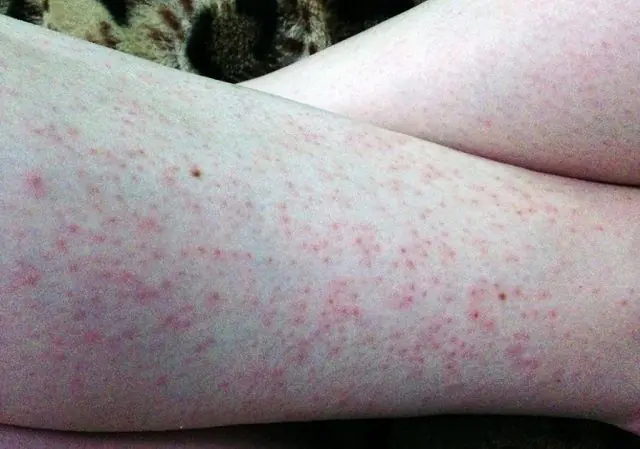
In the photo there is folliculitis after hair removal on the legs
Despite the fact that cosmetology offers many modern technologies for removing body hair, this does not prevent the appearance of folliculitis on the skin after hair removal. The causes of irritation are as follows:
- Lack of qualifications and experience of the master.
- Poor antiseptic treatment of instruments and skin.
- High sensitivity of the skin, especially delicate areas: face, bikini, armpits.
- An allergic reaction to applied cosmetics or painkillers before hair removal.
- Incorrectly adjusted light power or current pulse that caused a skin burn.
- After the procedure, the skin is not treated with emollients.
- A thick layer of hardened cells that prevent radiation from penetrating the follicle.
- Excessive hair removal.
- Between procedures, the client visits the pool, sauna/bath.
- Mechanical damage to the skin during manipulation.
In addition, the causes of folliculitis after hair removal may be predisposing factors:
- Diabetes mellitus and chronic diseases (malignant tumors, tuberculosis, digestive system).
- Thyroid diseases.
- Injuries (abrasions, scratches, burns, scratches).
- Acute infectious diseases (respiratory infections and influenza).
- Lack of protein in the body.
- Immunodeficiency state.
- People with HIV infection are at risk.
- Long-term use of hormonal drugs that worsen skin immunity.
Read more about diagnosing folliculitis.
What is folliculitis after hair removal - symptoms of the disease
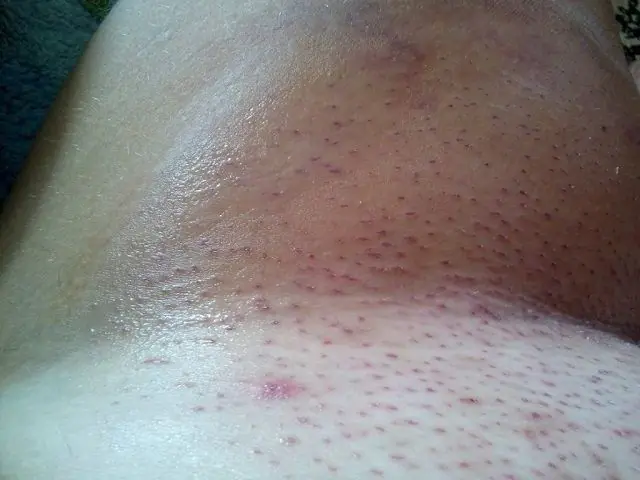
In the photo there is folliculitis after hair removal in the armpit area
Folliculitis is an infectious inflammation of the hair bulb (follicle), accompanied by the formation of purulent contents. As a rule, it appears the next day after hair removal. The pathology can be superficial and deep, affecting both women and men. Pathogenic bacteria enter the hair follicle and cause infection. It develops especially rapidly in the armpits and bikini area, since in these areas the supply of fresh air and increased sweating are limited. For this reason, after the hair removal procedure, it is recommended to wear cotton underwear and loose clothing, since the provoking factor of irritation is friction and poor ventilation due to synthetic materials. In this case, folliculitis after hair removal can appear on all areas of the body that have been treated.
The disease begins with redness of the skin around the follicle and a slight feeling of pain, after which small purulent pimples appear. If therapy is started at the wrong time or is prescribed incorrectly, then blood, lymph and breakdown products accumulate in the affected follicles, causing acne to enlarge, thicken and become painful. Folliculitis can be single or multiple.
If the inflammation is superficial, that is, it affects the upper layers of the follicle, then after a while the pus comes out and a crust forms, in place of which pigmentation may remain. It is forbidden to squeeze pimples with folliculitis with your hands, otherwise adjacent areas of the skin will become infected and treatment will be delayed. With a deep form of folliculitis, pus penetrates deeper into the follicle, the nodes reach 1 cm in diameter, itching appears, and the lymph nodes located nearby become enlarged.
- See also the symptoms of folliculitis after depilation
Complications after hair removal - ingrown hairs
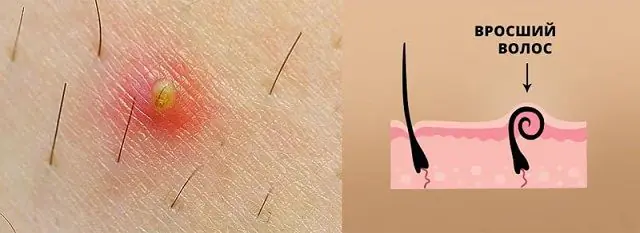
If, a few days after the procedure, redness and painful pimples appear on the skin, then the inflammatory process has begun. This is usually caused by ingrown hairs - this is one of the most common reactions, especially in people who suffer from folliculitis after hair removal. After the procedure, the skin becomes rough, and the growing hair becomes thinner and cannot grow through it. The hair becomes bent and grows back into the skin, which leads to the development of inflammation of the follicles, and when an infection occurs, to the appearance of ulcers and boils. Inflammation can spread from one hair follicle to another, causing damage to large areas of the skin.
To prevent ingrown hairs, it is necessary to take a shower with a scrub before the hair removal procedure, and disinfect the skin before and after the procedure. If the hair has grown into the skin, then steam the affected area: take a warm shower. Rub the affected area with a natural rough washcloth, the hair follicle will open and the hair will come out. If the hair has grown deeply, then only a specialist can remove it.
Treatment of folliculitis after hair removal: drug therapy

When the first signs of folliculitis appear, you should consult a dermatologist. At the appointment, the doctor will collect the patient’s medical history and determine the etiology of the disease, which will affect the effectiveness of treatment. To do this, the dermatologist will do the following:
- Examine the rash and examine the hair follicle.
- Determine concomitant diseases.
- Recognizes the tendency to allergic reactions.
- Determines immunodeficiency and hormonal disorders.
- Perform a dermatoscopy.
- He will refer you for analysis of the discharge from the pustules.
- Determine the pathogen.
- In order not to confuse the follicles with syphilis and gonorrhea, an RPR and PRC test will be prescribed.
To prevent folliculitis from becoming a chronic and acute inflammatory process, you need to start treatment as early as possible. As a therapeutic agent for mild inflammation, lesions are treated with solutions of aniline dyes: brilliant green, fucorcin, iodine, methylene blue. To prevent the rash from spreading to healthy areas, the skin is treated with salicylic/boric/camphor alcohol. Then bandages with antibacterial ointments are applied to the affected areas: Baziron, Zinerit, Skinoren or a compress with Ichthyol ointment. To reduce itching, take antiallergic drugs: Suprastin, Claritin, Lomilan.
If folliculitis has progressed to a deep or chronic stage, or an infected microdamage to the skin has occurred during hair removal, the following is prescribed:
- Antibiotics (Oxycort, Dermazolone, Clarithromycin, Amoxiclav).
- Antiviral drugs (Acyclovir).
- Antibacterial therapy (ointments: Mupirocin, Bactroban, Bonderm, tablets: Doxycycline, Erythromycin, Cephalosporin).
Regardless of the degree of skin damage by folliculitis, during the treatment period, especially with immunodeficiency, it is important to provide support to the body. To strengthen the immune system, take vitamin and mineral complexes: Immunal, Vitaferon, Timalin.
The effectiveness of treatment is observed in combination with physiotherapeutic methods: UV therapy. Ultraviolet rays enter the tissue, providing a general strengthening and anti-inflammatory effect.
- Read also about drug treatment of folliculitis after shaving
Treatment of folliculitis after hair removal: traditional methods

Natural remedies that can be done at home will help you cope with folliculitis after hair removal, but only simultaneously with medications. The most effective means are considered:
- Aloe vera juice, which is used to wipe the affected areas. The plant has antibacterial and anti-inflammatory properties, relieves burning and itching, and moisturizes the skin.
- Calendula decoction, which is used to treat diseased lesions. 5 g of dried flowers are poured into 200 ml of water, boiled in a water bath for 10 minutes and filtered.
- Dandelion leaf decoction strengthens the immune system. 2 tsp. The plants are poured with 200 ml of water, boiled for 10 minutes, cooled and filtered.
- Burdock root ointment applied to the lesions. 100 g of fresh root, pour 0.5 liters of water and boil for 5 minutes. Leave for 2 hours, mix with lard to a mushy consistency and heat the mixture in the oven at 100°C for 3 hours.
- Echinacea tablets have antibiotic properties. Take them in a dosage of 1-2 tablets per day between meals.
- Bergamot essential oil has an antibacterial effect. They wipe the affected areas of the skin.
Read about the treatment of folliculitis with folk remedies.
How to reduce irritation after hair removal?
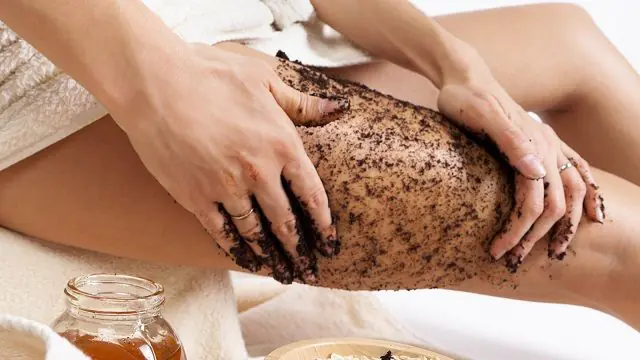
- A few days before the procedure, moisturize the skin.
- After the procedure, avoid getting water on the hair removal sites. Moisture will increase the negative skin reaction. To prevent inflammation, use baby powder or any product containing talc.
- After treatment, do not moisturize the skin with creams for the first day, but use absorbent powder. It will prevent the proliferation of bacteria in the follicles.
- To prevent the appearance of folliculitis, treat the skin with an antiseptic.
- To prevent ingrown hairs, treat the skin with a special product or soften it by exfoliating.
- If you have folliculitis, do not take hot baths or visit saunas or swimming pools.
- Wash your face with cool water, as hot temperatures stimulate sebum production.
- If folliculitis appears, stop removing hair from the affected areas of the body.
- Carry out hygiene procedures in affected areas using antibacterial soap.
- To disinfect the skin with folliculitis, use antiseptic solutions, for example, Chlorhexidine.
- Follow a diet: increase your intake of proteins, fresh fruits and vegetables and reduce fats, fast carbohydrates, sugary drinks and sweets.
Complications of folliculitis after hair removal
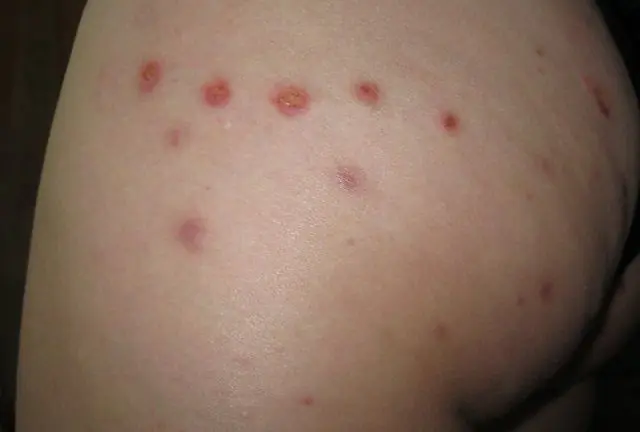
Folliculitis is not a life-threatening disease. The disease causes aesthetic discomfort and sometimes painful sensations to the patient. But if the disease is neglected, treatment is neglected and hygiene standards are not followed, then folliculitis will spread to adjacent areas of the skin with hair. This can lead to complications: scarring skin changes, carbuncles, boils, abscesses. In advanced cases, especially with reduced immunity, pneumonia, meningitis and kidney inflammation can develop.
How to get rid of irritation and acne after hair removal:
- Related article: what is superficial folliculitis



